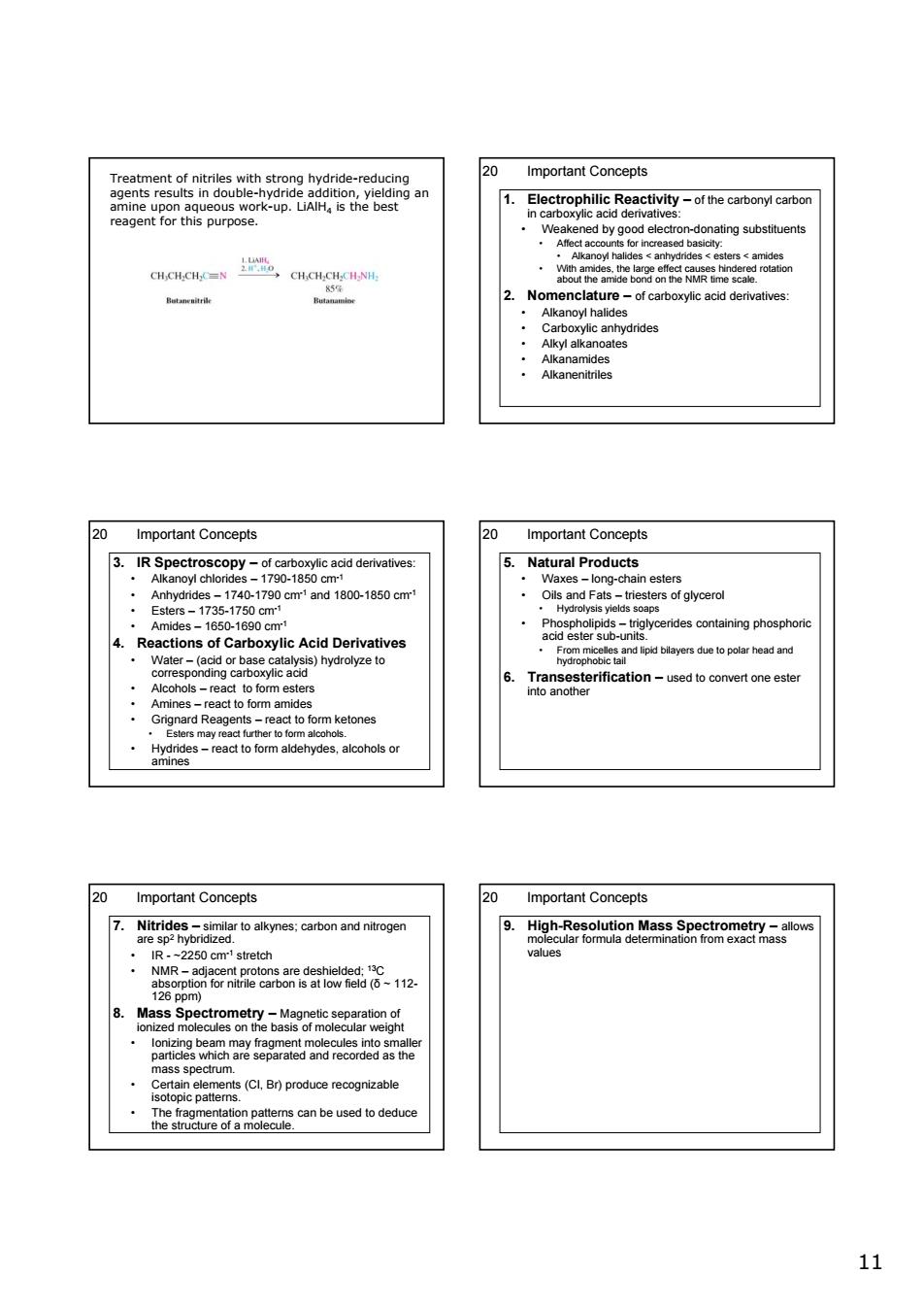正在加载图片...

20 Important Concepts 1.Electrophilic Reactivityof caco reagent for this purpose. ing sters amides NMR y 20 Important Concepts 20 Important Concepts 5. Natural Prod cts . cerides containing phosphori svesdelopolshea时and ateoosR Ncohos-ieaRem TOaseserfcation-usedtocomvetomeeste gents-re edtoformaldehydes,alcoholso 20 Important Concepts Important Concepts H2hReaoltoas3sPoctoemerssos cm1 stretch 11 Mass spect 11 11 Treatment of nitriles with strong hydride-reducing agents results in double-hydride addition, yielding an amine upon aqueous work-up. LiAlH4 is the best reagent for this purpose. 20 Important Concepts 1. Electrophilic Reactivity – of the carbonyl carbon in carboxylic acid derivatives: • Weakened by good electron-donating substituents • Affect accounts for increased basicity: • Alkanoyl halides < anhydrides < esters < amides • With amides, the large effect causes hindered rotation about the amide bond on the NMR time scale. 2. Nomenclature – of carboxylic acid derivatives: • Alkanoyl halides • Carboxylic anhydrides • Alkyl alkanoates • Alkanamides • Alkanenitriles 20 Important Concepts 3. IR Spectroscopy – of carboxylic acid derivatives: • Alkanoyl chlorides – 1790-1850 cm-1 • Anhydrides – 1740-1790 cm-1 and 1800-1850 cm-1 • Esters – 1735-1750 cm-1 • Amides – 1650-1690 cm-1 4. Reactions of Carboxylic Acid Derivatives • Water – (acid or base catalysis) hydrolyze to corresponding carboxylic acid • Alcohols – react to form esters • Amines – react to form amides • Grignard Reagents – react to form ketones • Esters may react further to form alcohols. • Hydrides – react to form aldehydes, alcohols or amines 20 Important Concepts 5. Natural Products • Waxes – long-chain esters • Oils and Fats – triesters of glycerol • Hydrolysis yields soaps • Phospholipids – triglycerides containing phosphoric acid ester sub-units. • From micelles and lipid bilayers due to polar head and hydrophobic tail 6. Transesterification – used to convert one ester into another 20 Important Concepts 7. Nitrides – similar to alkynes; carbon and nitrogen are sp2 hybridized. • IR - ~2250 cm-1 stretch • NMR – adjacent protons are deshielded; 13C absorption for nitrile carbon is at low field (δ ~ 112- 126 ppm) 8. Mass Spectrometry – Magnetic separation of ionized molecules on the basis of molecular weight • Ionizing beam may fragment molecules into smaller particles which are separated and recorded as the mass spectrum. • Certain elements (Cl, Br) produce recognizable isotopic patterns. • The fragmentation patterns can be used to deduce the structure of a molecule. 20 Important Concepts 9. High-Resolution Mass Spectrometry – allows molecular formula determination from exact mass values